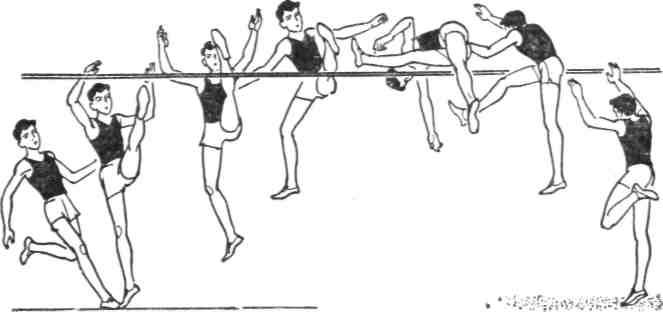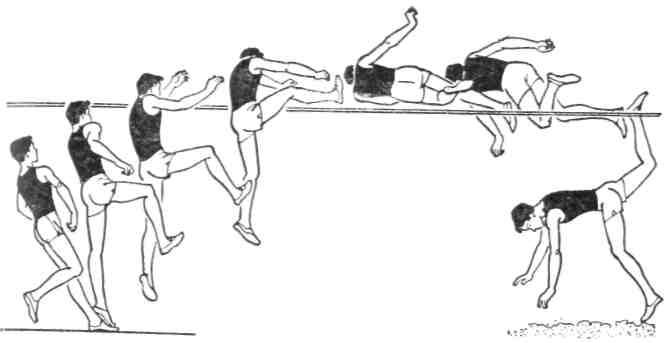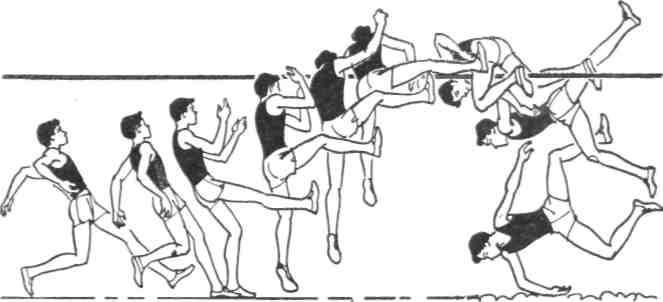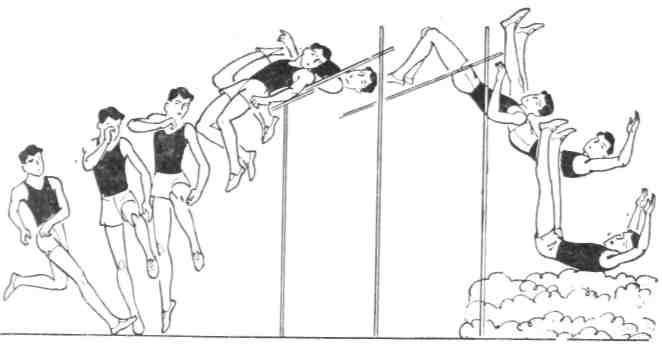The high jump is a complex athletic discipline in terms of coordination. It is performed after the preliminary run of the athlete. There are high demands on the athlete regarding physical training. Jumpers distinguish four main phases of the jump, which make up the process of its implementation. It all starts with a run, after which there is a repulsion with a further flight over the bar. The process ends with landing.
As for world achievements in such a discipline as high jump, the record for women now belongs to Bulgarian S. Kostadinova, and for men - Cuban H. Sotomayor. The gymnasts overcame the bars, which were set at a height of 209 cm and 245 cm, respectively. In an effort to improve performance, experts are developing all sorts of techniques and methods of jumping, which will be discussed later.
First, let's talk about old methods. The most ancient and simple view jumping is gymnastic. Its principle is that the athlete's swing leg moves over the bar after a run at a right angle. In this case, the landing of the jumper occurs on two legs. For a long time, the high jump was carried out in another way, called "scissors". Its essence is that after the athlete’s takeoff run at an angle of up to 40 degrees, the swing leg abruptly throws over the bar, and the leg that repels is transferred in parallel with it. Due to the high center of gravity of the body high results using this method is almost impossible to achieve. The high jump, which is called the "wave", is a variation of the previous one and its continuation, but now almost no one uses this technique.
 Special attention deserves the way of jumping, called "roll". It is one of the most rational species. Its main feature is that the jumper is repelled by the foot, which is closer to the bar. After the push, the fly leg assumes a straightened state. At the same time, the torso rotates with the push leg pressed against the chest. The run-up takes place at an angle of 45 degrees, and the athlete stretches along the bar and moves sideways through it. When the high jump is carried out in this way, the landing occurs on both hands and the pushing leg.
Special attention deserves the way of jumping, called "roll". It is one of the most rational species. Its main feature is that the jumper is repelled by the foot, which is closer to the bar. After the push, the fly leg assumes a straightened state. At the same time, the torso rotates with the push leg pressed against the chest. The run-up takes place at an angle of 45 degrees, and the athlete stretches along the bar and moves sideways through it. When the high jump is carried out in this way, the landing occurs on both hands and the pushing leg.
In the course of the development of this technique, another version of it appeared. She was named " flip jump”and boils down to the fact that the gymnast turns the torso more and overcomes the bar in the belly down position. The takeoff angle here, in contrast to the "roll", is up to 40 degrees.
 The most common and popular now is the method by which most professional gymnasts perform high jumps - the "flop" technique. It was first shown by V. Fasbury in Mexican Olympic Games in 1968. When using it, the athlete performs a run along an imaginary arc with a radius of about 12 meters on the toes, which allows to lower the center of gravity. Significantly helps with this wave of hands. The push is very powerful due to the high horizontal speed that was developed during the run. First, the gymnast in flight is with his back to the bar. Further, the push leg at the knee is bent, and the thigh of the flywheel is straightened. Due to the bending of the lumbar part of the back of the athlete at the time when he moves over the bar, the high jump provides a very economical transition.
The most common and popular now is the method by which most professional gymnasts perform high jumps - the "flop" technique. It was first shown by V. Fasbury in Mexican Olympic Games in 1968. When using it, the athlete performs a run along an imaginary arc with a radius of about 12 meters on the toes, which allows to lower the center of gravity. Significantly helps with this wave of hands. The push is very powerful due to the high horizontal speed that was developed during the run. First, the gymnast in flight is with his back to the bar. Further, the push leg at the knee is bent, and the thigh of the flywheel is straightened. Due to the bending of the lumbar part of the back of the athlete at the time when he moves over the bar, the high jump provides a very economical transition.
High jumps with a run - a type of athletics, characterized by short-term muscular efforts of an "explosive" nature, which has many varieties (methods). The main ones are "stepping", "wave", "roll", "flip" and "fosbury flop".
The most effective jumping methods are the flip and the fosbury flop.
High jump technique
Regardless of the method of overcoming the bar, the high jump consists of a run-up, repulsion, crossing the bar and landing. The most effective jumping methods are the flip and the fosbury flop. The modern high jump technique is characterized by the effective use of a high take-off speed, powerful repulsion, which is in the nature of a jet-power push, and an economical transition of the bar with the lowest possible location of the athlete's body BCT.
The run-up in high jumps is usually 7-9 running steps (11-14 w). The angle of take-off in relation to the bar depends on the method of the jump. When "stepping over" and "rolling" it is 35-45°, with "overlapping" - 25-35° and when jumping "wave" - 75-90°. The take-off run in the Fosber Flop method is performed along a curved line. Starting it at an angle of 65-75°, at the end of the run, the athlete, as it were, "runs" sideways to the bar, reducing the angle to 25-30°.
A run can be performed from a place or from an approach, when the jumper takes several accelerating steps and then, having hit the mark with his foot, starts running. One of the tasks of a jumper in the takeoff is to acquire the necessary horizontal speed, which should increase gradually, reaching 6.5-7.5 m / s by the time of repulsion.
The first half of the run is no different from the usual accelerated run. The increase in speed occurs in parallel with the increase in stride length. In the second part of the run, the athlete prepares for repulsion. To do this, the length of the last steps increases, and the BCT of the body decreases. The penultimate step in the run is the longest, the last one is shorter. Decreasing the last stride allows the athlete to quickly move the body onto the take-off leg, bring the pelvis forward, and minimize the loss of run-up speed. V. M. Dyachkov gives for orientation the averaged data of the last three steps of the run of the best Soviet jumpers: the 3rd step from the push is 215-220 cm, the penultimate one is 220-230 cm and the last one is 195-200 cm.
Success in repulsion largely depends on the speed and rhythm of the run. The run-up speed increases the efficiency of the push, but it is limited by the level of development of the speed-strength qualities of the athlete and is strictly individual. The run-up rhythm has a number of variations. However, any rhythm is characterized by a gradual increase in speed with accentuated acceleration at the end of the run. To mark the run-up, two marks are made: one at the beginning of the run-up and the other at the 3rd step from the take-off point.
Push. Repulsion begins from the moment the ground is touched by the pushing leg. However, its effectiveness largely depends on the movements performed in the previous (penultimate) step with the swing leg.
At the moment of placing the fly leg on the support, the athlete gently bends it and moves the knee forward. Simultaneously with moving forward on a strongly bent fly leg and its transition from the heel to the forefoot, the body assumes a vertical position, the pelvis is ahead of the axis of the shoulders, and the pushing leg overtakes the line of the pelvis. The fly leg actively unbends, changing the direction of movement of the body's BCT forward and upward, the arms through the sides are retracted.
The push leg is placed on the support from the heel without any impact, almost straightened. After depreciation flexion of the leg in the knee joint (up to 130°) and the transition from the heel to the entire foot, its accelerated extension begins.
The action of the push forces directed along the vertical is also facilitated by the extension of the torso and the swing of the free leg and arms up. The fly leg can be bent or straightened. Good mobility in the hip joint allows you to perform a wide swing with an almost fully extended leg, which can be considered a positive factor. By the moment of separation from the support, the pushing leg and torso are straightened, the swing leg is raised, the knee is at chest level.
Figure 32.
Flight. At first, the jumper maintains a vertical position for some time, somewhat delaying the rotation of the body along the main axes (longitudinal, transverse, and anterior-posterior), which began during repulsion, along the main axes. At the same time, by relaxing his muscles, he prepares to perform the movements necessary for a rational transition through the bar. Further actions of the jumper depend on the jump method chosen by him.
Landing. The task of landing is to extinguish the speed of rotation of the body along one axis or another, acquired during repulsion and transition through the bar. The athlete needs to land softly without any injury or pain. The nature of the landing is determined by the method of the jump and can be performed on the fly or push leg, on the leg and arm, on the hands, followed by a roll over the shoulder to the back. The presence of a high pillow made of synthetic materials allows landing directly on the back.
The way of "stepping over"(Fig. 32) is the simplest, but the least effective. The run is performed at an angle of 35-45 °, and repulsion is 60-80 cm from the edge of the pit with the foot farthest from the bar. The takeoff is carried out sideways to the bar, the fly leg is parallel to the bar, and the push leg is freely lowered down. Following this, at the highest point of take-off, the actual “stepping over” occurs, when the fly leg goes down, and the push leg goes up with an outward turn. As a result of these movements, the body turns to the bar and the push leg, leans towards the run-up, and the pelvis quickly passes over the bar. At the same time, the hands go down and slightly parted to the sides. The push leg is carried over the bar, and the landing occurs sideways to the bar on the fly leg.
Wave method(Fig. 33) got its name in connection with the sequential, as it were, undulating transfer of individual parts of the body through the bar. In a jump in this way, the run-up is performed at a right angle to the bar or at an angle of 75-90 °.
The repulsion point is 120-150 cm from the edge of the pit. The movements of the jumper in flight are characterized by their speed and relatively complex coordination. When, after repulsion and takeoff, the foot and shin of the fly leg rise above the bar, the athlete actively lowers the leg down, turning the toe inward. At the same time, the jumper turns the body towards the push leg and tilts it down (chest to the bar). The push leg is pulled up and out. As a result, the body of the jumper assumes an arcuate position when the pelvis is at the highest point. At the same time, the arms are lowered down or spread apart to the sides and back.

Figure 33.
Following this, the push leg is transferred over the bar and lowered down. The fly leg is pulled back, which allows you to overcome the bar without knocking it down with your chest or hands. These compensatory movements separate parts the bodies are undulating in nature - the jumper, as it were, wraps around the bar, transferring through it first the fly leg, then the pelvis, the push leg and, finally, the upper body and arms. Landing occurs on the push leg (chest to the bar).
Some distribution among women has received an intermediate between "stepping over" and "wave" way of jumping - "half-wave". In such a jump, the run is performed at an angle of 50-70 °, and the movement above the bar resembles a wave, but without the second part of the jump (lowering the push leg down).
The "roll" method(Fig. 34). The run is performed at an angle of 35-45 ° from the side of the jogging leg. The jumper is repelled 80-100 cm from the projection of the bar with the foot closest to it. The takeoff, preparation for the push and repulsion are performed in the same way as in the "crossover". Having made a swing, the jumper leans towards the bar. When the fly leg and arms are above the bar, he pulls the push leg under the fly leg thigh and finds himself in a horizontal position sideways to the bar.

Figure 34.
During takeoff, the jumper leans towards the bar. When the swing leg and arms rise above the bar, the push leg, bending, is pulled to the chest with the knee. The fly leg is extended along the bar, and the jumper turns out to be, as it were, lying sideways with the push leg bent and the pelvis raised high. Continuing the rotational movement along the longitudinal axis, the athlete lowers the fly leg, arms and upper body beyond the bar and then, turning his chest to the pit, lands on the push leg and arms.
In the practice of jumping by the “roll” method, there are 3 options for crossing the bar, depending on the position of the body at the highest point of the jump: sideways, back and dive. With the latter option, the athlete, as it were, dives beyond the bar, quickly bending the body at the hip joints and lowering the swing leg and torso beyond the bar. This option is the most effective, as it provides the pelvic lift necessary for the transition of the bar.
The "toggle" method (Fig. 28) is the most effective. The run is performed at an angle of 25-35 ° to the bar from the side of the push leg. The place of push is 60-90 cm from the near edge of the pit. In this way of jumping, the swinging movement of the free leg, combined with the push, is of paramount importance. Carrying along right side pelvis, the movement of the free leg contributes to the rotation of the body of the jumper along the longitudinal axis towards the bar. The fly leg can be bent or straightened. A quick swing of the arms increases the repulsion efficiency. The body of the jumper, which at first was held vertically, gradually assumes a horizontal position and turns to the bar with the chest. Known role the hands also play in this rotation. Right hand(if the pushing leg is left) moves more vigorously and with greater amplitude. Following this, the athlete transfers his right hand over the bar, lowering his shoulder and head behind it.
To enhance the longitudinal rotation, the fly leg is extended along the bar, and the push leg is pulled towards the body. When the swing leg is behind the bar with the toe down, the jumper turns the pelvis along the longitudinal axis and at the same time moves the bent push leg with his knee to the side-up, as if “rolling” over the bar. “Escape” from the bar is facilitated by diving with the head and upper body behind the bar in the longitudinal direction. A variant is possible in which the pushing leg at the moment of lowering the body behind the bar gradually straightens with the foot up. However, this method is less efficient, since it does not sufficiently increase the torque.

Figure 35.
Landing at flip way the jump is complicated by the rotation of the body along the longitudinal and transverse axes, which continues after overcoming the bar. Therefore, the athlete must reduce the speed of this rotation and try to land softly on his hands and fly leg, rolling over his shoulder and right side.
Fosbury flop method(Fig. 36). The indisputable advantage of this method lies in the possibility of greater use of horizontal speed for vertical lifting of the body than in jumping in other ways. The athlete here does not need a complex coordination restructuring of movements from the run to the push, take-off and transition of the bar. The run in this method is performed in an arc (with overrunning) and starts at an angle of 65-75 ° to the bar. In terms of technique and rhythm, it resembles a run in a long jump. On the last steps (during the transition to the clean and jerk), there is no lowering of the body's BCT and squatting on the fly leg. This allows the jumper to maintain more horizontal speed. The push is performed almost sideways to the bar with the foot farthest from the bar slightly forward. In this regard, repulsion occurs with greater speed, which is facilitated by a short sharp swing of the free leg strongly bent at the knee.

Figure 36.
The torque obtained during the arcuate takeoff and push allows the jumper to turn his back to the bar during takeoff. Following this, he, as it were, lays his back on the bar, bending over it in the lower back. As soon as the pelvis is above the bar, the jumper bends the body at the hip joints, while simultaneously straightening the legs at the knee joints and, as it were, pulling them towards him. Landing occurs on a rounded back, and sometimes on the occipital region, which necessitates special equipment for a landing site.









